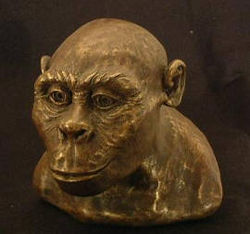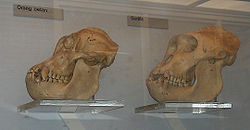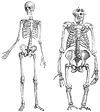Great ape
| Hominids[1] Fossil range: 7–0 Ma Late Miocene to Recent |
||||||||||||||||||
|---|---|---|---|---|---|---|---|---|---|---|---|---|---|---|---|---|---|---|
 Australopithecus africanus reconstruction
|
||||||||||||||||||
| Scientific classification | ||||||||||||||||||
|
||||||||||||||||||
| Genera | ||||||||||||||||||
|
The great apes are the members of the biological family Hominidae which includes humans, chimpanzees, gorillas, and orangutans.[1][2]
Contents |
Characteristics
The great apes are large, tailless primates, with the smallest living species being the Bonobo at 30 – 40 kilograms in weight, and the largest being the gorillas, with males weighing 140 – 180 kilograms. In all great apes, the males are, on average, larger and stronger than the females, although the degree of sexual dimorphism varies greatly among species. Although most living species are predominantly quadrupedal, they are all able to use their hands for gathering food or nesting materials, and, in some cases, for tool use.[3]
Most species are omnivorous, but fruit is the preferred food among all but humans. Chimpanzees and orangutans primarily eat fruit. When gorillas run short of fruit at certain times of the year or in certain regions, they resort to eating shoots and leaves, often of bamboo, a type of grass. Gorillas have extreme adaptations for chewing and digesting such low-quality forage, but they still prefer fruit when it is available, often going miles out of their way to find especially preferred fruits. In contrast, humans consume a large proportion of highly processed, low fiber foods, unusual proportions of grains and vertebrate flesh, as well as a wide variety of other foodstuffs. The teeth are similar to those of the Old World monkeys and gibbons, although they are especially large in gorillas. The dental formula is:
| 2.1.2.3 |
| 2.1.2.3 |
Human teeth and jaws are markedly smaller for our size than those of other apes. Some scholars have surmised that humans' small teeth and jaws are adaptations to eating cooked food for possibly as long as a million years or more.[4] This idea remains controversial.
Gestation in great apes lasts 8-9 months, and results in the birth of a single offspring, or, rarely, twins. The young are born helpless, and the mother must care for them for long periods of time. Compared with most other mammals, great apes have a remarkably long adolescence, not being weaned for several years, and not becoming fully mature for 8-13 years in most species (longer in humans). As a result, females typically give birth only once every few years. There is no distinct breeding season.[3]
Gorillas and chimpanzees live in family groups of around five to ten individuals, although much larger groups are sometimes noted. Chimpanzees live in larger groups that break up into smaller groups when fruit becomes less available. When small groups of female chimpanzees go off in separate directions to forage for fruit, the dominant male(s) can no longer control them and the females often mate with other subordinate males, whether by choice or not. In contrast, groups of gorillas stay together regardless of the availability of fruit. When fruit is hard to find, they resort to eating leaves and shoots. Because gorilla groups stay together, the male is able to monopolize the females in his group. This fact is related to gorillas' greater sexual dimorphism than chimpanzees'. In both chimpanzees and gorillas, the groups include at least one dominant male, and females leave the group at maturity. By contrast, orangutans are generally solitary. The social structure of humans is complex and highly variable. DNA studies suggest that, as in other apes, female humans are the sex that leaves the group at maturity, or at least has done so over evolutionary time.
Classification
This classification of the great apes has been revised several times in the last few decades. Also see hominid for a helpful clarification of terms. Originally, the group was restricted to humans and their extinct relatives, with the other great apes being placed in a separate family, the Pongidae. This definition is still used by many anthropologists and by lay persons. However, that definition makes Pongidae paraphyletic, whereas most taxonomists nowadays encourage monophyletic groups. Thus many biologists consider Hominidae to include Pongidae as the subfamily Ponginae, or restrict the latter to the orangutans and their extinct relatives like Gigantopithecus. The taxonomy shown here follows the monophyletic groupings.
Especially close human relatives form a subfamily, the Homininae. Some researchers go so far as to include chimpanzees[5] and gorillas[6][7] in the genus Homo along with humans, but it is more commonly accepted to describe the relationships as shown here.
Many extinct hominids have been studied to help understand the relationship between modern humans and the other extant hominids. Some of the extinct members of this family include Gigantopithecus, Orrorin, Ardipithecus, Kenyanthropus, and the australopithecines Australopithecus and Paranthropus.
The exact criteria for membership in the Homininae are not clear, but the subfamily generally includes those species that share more than 97% of their DNA with the modern human genome, and exhibit a capacity for language or for simple cultures beyond the family or band. The theory of mind including such faculties as mental state attribution, empathy and even empathetic deception is a controversial criterion distinguishing the adult human alone among the hominids. Humans acquire this capacity at about four and a half years of age, whereas it has neither been proven nor disproven that gorillas and chimpanzees develop a theory of mind.[8] This is also the case for some New World monkeys outside the family of great apes, as, for example, the capuchin monkeys.
However, without the ability to test whether early members of the Homininae (such as Homo erectus, Homo neanderthalensis, or even the australopithecines) had a theory of mind, it is difficult to ignore similarities seen in their living cousins. Despite an apparent lack of real culture and significant physiological and psychological differences, some say that the orangutan may also satisfy these criteria. These scientific debates take on political significance for advocates of Great Ape personhood.
Evolution

On July 19, 2001, a 7 million year old fossil skull nicknamed "Toumaï" by its discoverers, and formally classified as Sahelanthropus tchadensis, was discovered in Chad and is possibly the earliest hominid fossil ever found. In addition to its age, Toumaï, unlike the 3 – 4 million year younger gracile australopithecine dubbed "Lucy", has a relatively flat face without the prominent snout seen on other pre-Homo hominids. Some researchers have made the suggestion that this previously unknown species may in fact be a direct ancestor of modern humans (or at least closely related to a direct ancestor). Others contend that one fossil is not enough to make such a claim because it would overturn the conclusions of over 100 years of anthropological study. A report on this finding was published in the journal Nature on July 11, 2002. While some scientists claim that it is merely the skull of a female gorilla ancestor, others have called it the most important hominin fossil since Australopithecus.
In addition to the Toumaï fossil, some experts use evidence from the genome to argue that the species associated with the chimpanzees and proto-humans split interbred over a long period of time, swapping genes, before making a final separation. A paper, whose authors include David Reich and Eric Lander (Harvard and MIT), was published in the journal Nature in May 2006.[9]
It is generally believed that the Pan/Homo split occurred about 6.5–7.4 million years ago, but the molecular clock (a method of calculating evolution based on the speed at which genes mutate) suggests the genera split 5.4–6.3 million years ago. Previous studies looked at average genetic differences between human and chimp. The new study compares the ages of key sequences of genes of modern humans and modern chimps. Some sequences are younger than others, indicating that chimps and humans gradually split apart over a period of 4 million years. The youngest human chromosome is the X sex chromosome which is about 1.2 million years more recent than the 22 autosomes. The X chromosome is known to be vulnerable to selective pressure. Its age suggests there was an initial split between the two species, followed by gradual divergence and interbreeding that resulted in younger genes, and then a final separation.
Species

The seven living species of great ape are classified in four genera.
- Family Hominidae: humans and other great apes; extinct genera and species excluded.[1]
- Subfamily Ponginae
- Genus Pongo
- Bornean Orangutan, Pongo pygmaeus
- Pongo pygmaeus pygmaeus
- Pongo pygmaeus morio
- Pongo pygmaeus wurmbii
- Sumatran Orangutan, Pongo abelii
- Bornean Orangutan, Pongo pygmaeus
- Genus Pongo
- Subfamily Homininae
- Tribe Gorillini
- Genus Gorilla
- Western Gorilla, Gorilla gorilla
- Western Lowland Gorilla, Gorilla gorilla gorilla
- Cross River Gorilla, Gorilla gorilla diehli
- Eastern Gorilla, Gorilla beringei
- Mountain Gorilla, Gorilla beringei beringei
- Eastern Lowland Gorilla, Gorilla beringei graueri
- Western Gorilla, Gorilla gorilla
- Genus Gorilla
- Tribe Hominini
- Genus Pan
- Common Chimpanzee, Pan troglodytes
- Central Chimpanzee, Pan troglodytes troglodytes
- West African Chimpanzee, Pan troglodytes verus
- Nigerian Chimpanzee, Pan troglodytes vellerosus
- Eastern Chimpanzee, Pan troglodytes schweinfurthii
- Bonobo (Pygmy Chimpanzee), Pan paniscus
- Common Chimpanzee, Pan troglodytes
- Genus Homo
- Human, Homo sapiens sapiens
- Genus Pan
- Tribe Gorillini
- Subfamily Ponginae
In addition to the extant species and subspecies above, archaeologists, paleontologists, and anthropologists have discovered numerous extinct species. The list below are some of the genera of those discoveries.
- Subfamily Ponginae
- Gigantopithecus†
- Sivapithecus†
- Lufengpithecus†
- Ankarapithecus†
- Ouranopithecus†
- Subfamily Homininae
Legal status
Due to the close genetic relationship between humans and other great apes, certain animal rights organizations, such as the Great Ape Project, argue that non-human great apes are persons and should be given basic human rights. Some countries have instituted a research ban to protect great apes from any kind of scientific testing.
On 25 June 2008, the Spanish parliament gave support for a new law that would make "keeping apes for circuses, television commercials or filming" illegal under Spain's penal code.[10]
See also
- Great ape language
- The Mind of an Ape
- List of non-human apes – notable individual apes
- Ape extinction
- Great Apes Survival Project
- Declaration on Great Apes
- Kinshasa Declaration on Great Apes
- Evolution of Homo sapiens
- Graphical timeline of human evolution
bgc3
References
- ↑ 1.0 1.1 1.2 Groves, C. (2005-11-16). Wilson, D. E., and Reeder, D. M. (eds). ed.. Mammal Species of the World (3rd edition ed.). Johns Hopkins University Press. pp. 181-184. ISBN 0-801-88221-4. http://www.bucknell.edu/msw3/browse.asp?id=12100786.
- ↑ "Great ape" is a common name rather than a taxonomic label and there are differences in usage. Subtly, it may seem to exclude human beings ("humans and the great apes") or to include them ("humans and non-human great apes"). Homo sapiens is not at any especial remove from other members of the biological family, and humans are therefore described here as great apes.
- ↑ 3.0 3.1 Harcourt, A.H., MacKinnon, J. & Wrangham, R.W. (1984). Macdonald, D.. ed.. The Encyclopedia of Mammals. New York: Facts on File. pp. 422-439. ISBN 0-87196-871-1.
- ↑ Richard Wrangham. "The Cooking Enigma". in Charles Pasternak (ed.). What Makes Us Human?. Oxford: Oneworld Press.
- ↑ Pickrell, John (2003-05-20). "Chimps Belong on Human Branch of Family Tree, Study Says". National Geographic. Retrieved on 2007-08-04.
- ↑ Relationship Humans-Gorillas
- ↑ Watson, E. E. et al. (2001). "Homo genus: a review of the classification of humans and the great apes". in eds. Tobias, P. V. et al.. Humanity from African Naissance to Coming Millennia. Florence: Firenze Univ. Press. pp. Pp. 311-323.
- ↑ Heyes, C. M. (1998). "Theory of Mind in Nonhuman Primates". Behavioral and Brain Sciences 21. doi:. bbs00000546. http://www.bbsonline.org/documents/a/00/00/05/46/index.html.
- ↑ Patterson, Nick; Richter, Daniel J.; Gnerre, Sante; Lander, Eric S.; Reich, David (2006), "Genetic evidence for complex speciation of humans and chimpanzees", Nature 441: 1103-1108, doi:, http://www.nature.com/nature/journal/v441/n7097/abs/nature04789.html
- ↑ "Spanish parliament to extend rights to apes". Reuters (2008-06-25). Retrieved on 2008-07-11.
External links
- Additional information on great apes
- NPR News: Toumaï the Human Ancestor
- Hominid Species at talkorigins.org
- For more details on Hominid species, including excellent photos of fossil hominids
- New Scientist 19 May 2003 – Chimps are human, gene study implies
- Scientific American Magazine (April 2006 Issue) Why Are Some Animals So Smart?
|
|||||||||||
|
||||||||||||||||||||||||
|
|||||||||||||

